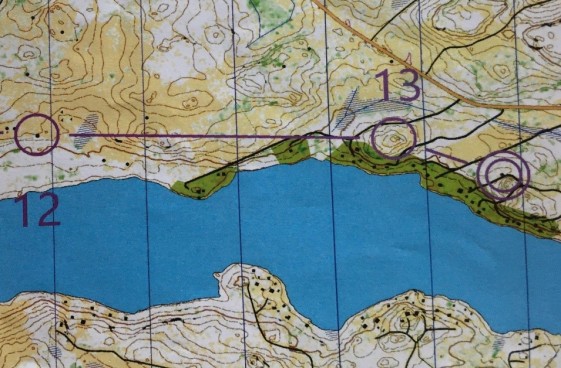Dear blog and readers,
Two years ago, I discovered that orienteering might be fun. One of the members of our badminton club is active orienteer and mapper. He organized for us a spring happening, which was about orienteering from his summer cottage to another cottage at another lake about 10 kilometers away. The destination and the last virtual controls are shown in Image 1. Along the way we learnt lessons about orienteering and the forest. At the destination cottage we then had sausages, sauna and reflection.

Image 1: The last controls of the badminton club spring happening (Photo by Matti Karlsson 2020)
There was also continuation to this in the following year, as we participated in a big relay orienteering happening as a team of seven men. After that happening many of us continued the hobby. This spring the corona crisis stopped most of the sports activities. Orienteering turned out to be a perfect way to do outdoor sports, because you can do it alone.
Orienteering and course design
There is a reason why I write about orienteering. I think orienteering has a lot of similarities with learning and teaching, and course design. As the teacher, you design the courses for the students, who then navigate through the courses and learn. The map is a model of the real terrain, exactly as the theories are models of the real-world phenomena. As the teacher, you know the theories and the real world. Then you design the route and the control points through subject matters of the course, or let the students explore the new terrain more freely. As the teacher, you will provide for directions to help the students to find their way through the course. Having done these as a teacher, then the students will have the map and a compass for navigation through the course.
Obviously, there are many ways to design the courses. Maybe the simplest way is just to send the students in the forest of theories by recommending books and papers to read. Then you just hope they will find their way out (maybe at the same time accepting 10-50 % loss). However, there are better ways to do the course design and course facilitation, too.
Course design will have an impact on the flexibility of the course. According to Boelens, De Wever, & Voet (2017), increased flexibility implies that learners have some level of control over time, place, path, or pace. In order to improve flexibility of the course, collaboration should include asynchronous elements and individual study paths. However, in order to facilitate interaction, some activities should be designed to use synchronous modes, thus limiting the control over time. Furthermore, due to the curriculum level restrictions, the choice of pace is often limited as well.
Challenges of blended and online learning
According to Boelens, De Wever, & Voet (2017), flexibility and social interaction are kind of trade-offs in the course design. There should be many channels for collaboration, and it should be frequent. There should be also continuous checking and feedback, how to understand the instructions and discussions.
“Enlarged psychological and communication space (transactional distance) -> social interaction becomes more difficult and the instructors cannot immediately notice when learners encounter problems or what learners have actually learned. There maybe misunderstandings in the input of the instructors and that of the learners. This will mean a trade-off between the flexibility offered by the blended learning method and the social interaction and human touch of the face-to-face environment.” (Boelens, De Wever, & Voet 2017)
Further challenges on blended learning courses are the facilitation of the students’ learning processes and fostering an affective learning climate. In their research, Boelens, De Wever, & Voet (2017) have found that
“Self-regulation becomes a critical factor for success. Skills: organization, discipline, time management, skill in using technology to support learning, and self-efficacy to exercise control over their own learning processes.” (Boelens, De Wever, & Voet 2017)
They suggest using four different regulative strategies to facilitate the students’ learning processes: orienting and planning, monitoring, adjusting, and evaluating. To foster an affective learning climate, Boelens, De Wever, & Voet (2017) state that online interaction is often considered to be less spontaneous compared to face-to-face communication which might cause feelings of learner isolation.
“Therefore, foster a motivating and affective learning climate, which makes that learners feel safe, accepted and valued, and promotes positive attitudes towards the course and the instructor. Five categories of affective strategies are motivating, concentrating and exerting effort, attributing and judging oneself, appraising, and dealing with emotions.” (Boelens, De Wever, & Voet 2017)
The hero’s journey and the five-stage model
Now, after having had a look at the challenges, let’s go back to orienteering and adventures in the forests of theories. Before sending the students into deep forests, the teacher should make sure that they have required navigation skills and they are equipped to survive. Referring to Gilly Salmon’s five-stage model (2013), the first step of course design should be making sure that the students have access to needed resources. They should also have enough motivation to go through all the ordeals which they will face during the course.
In his book ‘The Hero With A Thousand Faces’, Joseph Campbell (2008) introduced the Hero’s Journey as a metaphor for transformative learning.
“Hero’s Journey reflects an inclusive conception of transformative learning theory that focuses on the centrality of emotion in the personal transformation experience. Through critical self-reflection, The Hero’s Journey provides a framework that guides individuals in understanding that significant personal growth and transformation are often accompanied by challenge and tension, but often the greater the challenge, the more significant the personal fulfilment and self- growth.” Willans (2012)
In the context of blended learning courses, for me the hero’s journey describes the student’s journey through new courses and unknown subject matters. The process becomes understandable by having a look at image 2 and reading the introduction to the concept in the following quotation from Wikipedia:
“In the departure part of the narrative, the hero or protagonist lives in the ordinary world and receives a call to go on an adventure. The hero is reluctant to follow the call, but is helped by a mentor figure. The initiation section begins with the hero then traversing the threshold to an unknown or “special world”, where he faces tasks or trials, either alone or with the assistance of helpers. The hero eventually reaches “the innermost cave” or the central crisis of his adventure, where he must undergo “the ordeal” where he overcomes the main obstacle or enemy, undergoing “apotheosis” and gaining his reward (a treasure or “elixir“). The hero must then return to the ordinary world with his reward. He may be pursued by the guardians of the special world, or he may be reluctant to return, and may be rescued or forced to return by intervention from the outside. In the return section, the hero again traverses the threshold between the worlds, returning to the ordinary world with the treasure or elixir he gained, which he may now use for the benefit of his fellow man. The hero himself is transformed by the adventure and gains wisdom or spiritual power over both worlds.” (https://en.wikipedia.org/wiki/Hero%27s_journey)

Image 2: The hero’s journey (by scan from an unknown publication by anonymous poster, in a thread, gave permission to use it. Re-drawn by User: Slashme – 4chan.org, thread about monomyths, AKA the hero’s journey, Public Domain, https://commons.wikimedia.org/w/index.php?curid=10284342)
The unknown world of the new theories is unknown to the students, but most of the time it should be familiar to the teacher. Therefore, with good course design, the teacher should make it clear which are the recommended routes through the new terrains and which are the control points along the way. However, with more advanced students, it makes sense to use ill-defined tasks, too.
By the ‘call to adventure’, the teacher should give the motivation to the students, as well as offer some ‘supernatural aid’ to help the students to start the course. On collaborative courses, the students do not have to do the journey alone, but they will have fellow students to support each other and the teachers to facilitate the journey. On collaborative courses, before starting to learn the subject matters, it is mandatory to go through the stage two (Salmon 2013), which is online socialization. The course participants should learn to work together before being exposed to difficult challenges of producing learning outcomes together.
When the students have been prepared for proceeding to the challenges of the unknown world, they will be exposed to new information, which is necessary to learn before being ready to enter the inmost cave of the ‘dragon’. In the five-stage model (Salmon 2013) this is stage three, information exchange. By using co-operative tasks (e-tivities), the students will learn together in a collaborative setting. The students will have helpers and mentors around to help with the challenges and temptations while performing these tasks. By doing all the tasks, the students will learn the necessary skills and grow into full membership of their community of practice.
Now the students (or heroes) are ready to fight the dragon and save the beautiful princess out of the dragon’s cave. By using all the skills that they learnt, they will confront the dragon and defeat it. This is stage four in Salmon’s (2013) model and it focuses on knowledge construction. In this stage, the learnt theories are applied to real-life ill-defined problems. This may turn out as a transformative experience, as the students learn how the theories work in practice and they can do it.
The last step is return to the known world, where they started the journey. This is the last step in Salmon’s (2013) model. Now the students will have a look back and reflect what they actually learnt during the journey. They should be ready to use the skills they learnt during the journey, and apply those in their normal environment.
In order to learn, I think this kind of experience through the five steps is necessary. Learning does not just happen by information exchange via online lessons, but there is a lot more to consider for a great blended learning course.
References
Boelens, R., De Wever, B., & Voet, M. (2017). Four key challenges to the design of blended learning: A systematic literature review. Educational Research Review, 22, 1-18. https://doi.org/10.1016/j.edurev.2017.06.001
Campbell, J. (2008) The Hero with a Thousand Faces. Princeton: Princeton University Press, 1968, p. 30 / Novato, California: New World Library, 2008 .
Salmon G. (2013) The five-stage model. https://www.gillysalmon.com/five-stage-model.html
Willans, Julie. (2012). The Hero’s Journey as a metaphor for personal transformation..